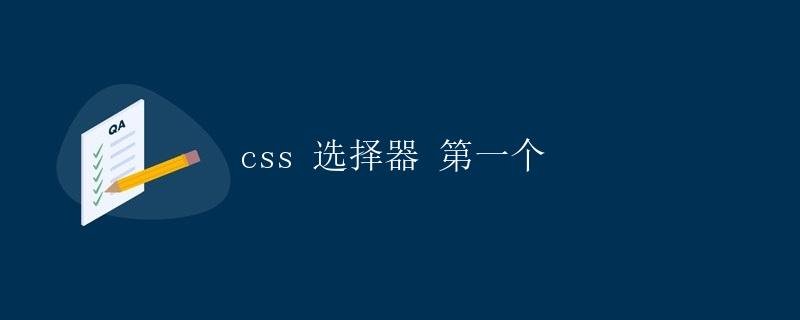CSS Selectors
CSS Selectors

CSS selectors are a syntax in CSS used to select one or more HTML elements and apply styles to them. CSS selectors can be used to select specific elements based on their tag names, class names, IDs, attributes, and more.
Introduction
When writing CSS stylesheets, we often need to select specific HTML elements and apply certain styles to them. For example, we might want to set the font color of all paragraph elements to red, or set the background color of a specific div element to blue.
CSS selectors allow us to select HTML elements based on various conditions, giving us more precise control over how styles are applied. CSS selectors are categorized into basic selectors, combined selectors, and attribute selectors, each with its own unique characteristics and uses.
In this article, we’ll focus on basic selectors in CSS, including tag selectors, class selectors, and ID selectors. These selectors are the most commonly used in CSS and form the foundation for learning CSS.
Tag Selectors
Tag selectors are one of the simplest selectors in CSS. They select elements by specifying their tag names. For example, to select all paragraph elements (p), you can use the following tag selector:
p {
color: red;
}
The above code will set the text color of all paragraph elements to red. Tag selectors are useful for styling all identical HTML elements on a web page.
Class Selectors
Class selectors are one of the most widely used selectors in CSS. They select elements by specifying their class name. A class selector begins with . followed by the class name. For example, to select all elements with the class text, you could use the following class selector:
.text {
font-weight: bold;
}
The above code will set the text of all elements with the class text to bold. Class selectors make it easy to consistently style elements with the same class name.
ID Selector
The ID selector is one of the most important selectors in CSS. It selects an HTML element by specifying its ID. An ID selector starts with # followed by the ID value. For example, to select the element with the ID header, you can use the following ID selector:
#header {
background-color: blue;
}
The above code sets the background color of the element with the ID header to blue. ID selectors are the most powerful selectors in CSS and are suitable for customizing styles for specific elements.
Descendant Selectors
A descendant selector is a compound selector used to select descendants of an element. A descendant selector joins two selectors with a space. For example, to select all paragraph elements within a div element, you can use the following descendant selector:
div p {
color: green;
}
The above code will set the text color of all paragraph elements within a div element to green. Using descendant selectors, we can more precisely select elements within nested structures.
Pseudo-class Selectors
Pseudo-class selectors are special selectors used to select specific states or positions of HTML elements. Common pseudo-class selectors include hover, active, and focus. For example, to style a link when the mouse hovers over it, you can use the following pseudo-class selector:
a:hover {
color: orange;
}
The above code will set the link’s text color to orange when the mouse hovers over it. Pseudo-class selectors can help us achieve special effects and enhance the user experience.
Summary
CSS selectors are a crucial part of CSS. They allow us to apply styles to specific HTML elements, thus personalizing the design of web pages. This article introduces basic selectors in CSS, including tag selectors, class selectors, ID selectors, descendant selectors, and pseudo-class selectors. By flexibly applying these selectors, we can more conveniently control the style of web pages and achieve the desired effects.